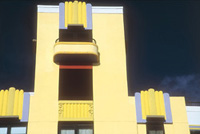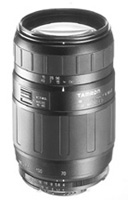SP AF 24 to 135mm f3.5to 5.6AD IF Macro And AF 70 to 300mm f4 to 5.6LD Macro From Tamron
Best known for selling over a million of the various versions of their 28-200mm zoom, Tamron makes a broad variety of lenses. In zooms, these range from highly affordable models to those intended to satisfy the professional photographer. Most recently, their designers have been working to make lenses with much closer focusing ability, a definite plus that increases versatility. This spring, while shooting stock in South Florida, I tested two very different models, covering the range from very wide to moderately long telephoto. The new SP AF 24-135mm f/3.5-5.6AD [IF] Macro and AF 70-300mm f/4-5.6LD Macro have little in common, except for close focusing, but this duo is an excellent choice as a two-lens outfit. Because they include 90 percent of the focal lengths needed for travel photography, I could leave other lenses in the car and walk happily for miles carrying my smallest camera bag. SP AF 24-135mm f/3.5-5.6AD
[IF] Macro |
|||
A two part internal barrel (instead of a single fixed tube) helps keep this lens compact. Naturally, this internal barrel does extend when zooming to longer focal lengths, protruding by 2.8" at the 135mm end. The mount is made of stainless steel with gold-plated electronic contacts; the barrel is constructed of aluminum alloy with some polycarbonate components for durability. The designers also included a Zoom Lock mechanism that can be set at 24mm so the lens does not extend while you're carrying the camera around. The removable corner-cut (notched) lens hood is designed to shade the front element from stray light at all focal lengths without intruding on the image area. The optical formula includes a unique Anomalous Dispersion element. Tamron says this optimizes the dispersion characteristics of the optical system to compensate for lateral chromatic aberration at wide angle settings and helps compensate for chromatic aberration at longer focal lengths as well. Four Hybrid Aspherical elements help provide high image quality across the frame at short focal lengths. Made by bonding a non-spherical surface onto conventional glass, these are far less expensive to produce than ground and polished aspherical elements, but offer similar benefits. They correct distortion and spherical aberration (curvature of field) for more consistent edge-to-edge sharpness even at wide apertures, reduce comatic flare and linear distortion, and minimize size and weight as fewer elements are required. Focus is internal but the focus ring does rotate during AF operation; I had to hold this short lens carefully so my fingers would not impede its movement. Both focus and zoom rings are coated with rubber for a good grip. A distance scale in feet and meters is provided but there's no depth of field scale, as with most rotary zooms today. I simply used the camera's depth of field preview to assess the range of sharp focus. |
|||
General Evaluation It mated perfectly with an EOS-3 and all camera and flash functions operated perfectly. There was no looseness or "play" whatsoever. (The same applies to the 70-300mm zoom, too.) The notched lens hood worked well, but it's most effective at shorter focal lengths, like any hood on a wide to tele-zoom lens. In extreme sidelighting, I occasionally needed to change my shooting position slightly when flare was noticeable on the viewing screen. Autofocus operation was reasonably quiet and focus acquisition was quick. The manual focus mechanism is also well damped, with enough friction for a familiar "feel." I really appreciated the Internal Focusing (IF) mechanism when using a polarizer to enrich blue skies or to remove glare from art deco buildings at South Beach in Miami. Because the front element does not rotate, the effect of the filter was not altered during focus (or zooming) operation. |
|||
Optical Evaluation At one stop down from maximum aperture, image sharpness and resolution are high across the entire frame at all focal lengths. I could make sharp 11x14 prints from any of my slides. Peak performance is reached at around f/11 in the 28-80mm range; adequate for a sharp 16x20 print, with crisp definition of details as well as fine clarity, contrast, and color rendition. Some slight vignetting--darkening at the corners--is noticeable at the shortest focal lengths with subjects such as the sky, but disappears by f/5.6. This is common with zoom lenses, especially those of broad focal length range. There is little barrel or pincushion distortion: lines near the edges of the frame are rendered quite straight. In extreme close focusing, optimum image quality was produced in the f/11 to f/16 range. These are exactly the apertures that I would typically use in such work, for the depth of field required to keep an entire subject sharply rendered. Frankly, I'm convinced that this lens is suitable for professional applications and I would happily continue using it for my stock photography. An even wider aperture--perhaps f/2.8 at all focal lengths--would make it an ideal lens for photojournalism. However, the size, weight, and price would increase substantially, making the lens impractical for most photo enthusiasts. As denoted by the gold stripe and SP designation (for Super Performance) this is a lens of superior quality. Though not inexpensive, it rates high on the price/value scale and will help to maintain Tamron's already stellar reputation. |
|||
AF 70-300mm f/4-5.6LD Macro
This is a very light lens with metal lens mount and rubberized zoom and focus rings. It includes an element of LD (Low Dispersion) glass to reduce secondary chromatic aberration, the tendency for various wavelengths of light to focus at different distances. This element is useful at longer focal lengths, especially at wide apertures, for superior image sharpness, contrast, and color reproduction. Considering the low price of this zoom, its other characteristics are not surprising. The front element does rotate during focusing, though not when zooming. The focus mechanism is smooth but without much friction and it does rotate during AF operation. The internal barrel protrudes quite far out (a full 3.4") in Macro mode at 300mm, but it's made of lightweight polycarbonate so overall balance is not significantly affected. Evaluation |
|||
At more typical focusing distances, sharpness/contrast was very good from 70-200mm, especially at f/8 and f/11, where the slides are truly impressive and are suitable for an 11x14 print. At the longer focal lengths, central sharpness was high but edge sharpness did benefit from stopping down. I did not hesitate to shoot at 300mm at f/8 when filling the frame with colorful macaws at the Parrot Jungle in Miami. My slides would make for nice 8x12 prints. Slight pincushion distortion (bowing inward of lines near the edges of the frame) was observed, especially at longer focal lengths. Unless you plan to use a tele-zoom lens for formal architectural photography--highly unlikely--this factor is irrelevant. Flare is well controlled. The bayonet-type lens hood (removable for reversed storage) is very effective. Autofocus speed with the EOS-3 was good, capable of tracking vehicles traveling along a Florida freeway on bright days. AF operation is certainly not silent but is comparable to that of many other affordable zooms. |
|||
Advanced photographers who demand professional caliber sharpness, resolution, and clarity may prefer the "pro" SP AF 70-200mm f/2.8LD zoom, but as a first tele-zoom, the AF 70-300mm f/4-5.6LD Macro would be a more suitable choice. Far more portable, it also extends to longer focal lengths and allows for much closer focusing. It would be great for family outings, hikes, and vacation trips when you want to travel light. Finally, since Tamron lenses have a fine reputation for reliability, it should provide years of trouble-free picture taking. If the price, performance standards, and extreme close focusing ability suit your own demands, this Tamron lens would make for a suitable investment. For information contact Tamron USA Inc., 10 Austin Blvd., Commack, NY 11725; (631) 858-8400. |
|||
Technical Specifications |
|||
SP AF 24-135mm f/3.5-5.6AD
[IF] Macro |









































